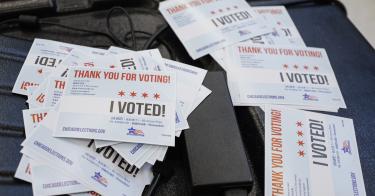Los Angeles County, a bastion of left-wing politics, removed 1.2 million ineligible voters from its voter rolls in February—a move the Democrats frequently call “purging” when officials in red states do it.
It’s hardly a purge when voters were inactive and included names of those who had either died or moved outside the county. Something California has become known for in recent years is an exodus of residents.
Los Angeles County didn’t follow federal law voluntarily, however. It did so after reaching a 2019 settlement in a lawsuit led by Judicial Watch, a government watchdog in Washington that teamed with California clients.
This action comes after New York City settled a similar case with Judicial Watch in December to remove 441,083 ineligible names from the voter rolls.
Voter fraud is a real concern in this country.
>>> 10 New Cases of Vote Fraud Again Demonstrate Imperative of Election Security
Los Angeles County, which encompasses Compton, is familiar with the problem, after a 2021 Compton City Council election was overturned because of voter fraud.
Also recently, six Minnesota counties removed a total of 501 duplicate names of voters from their list after separate settlements with the Public Interest Legal Foundation, another watchdog group, which sued in September.
It’s not just blue states. The Judicial Watch reached a February 2022 settlement with North Carolina in which two counties removed more than 430,000 inactive voters. North Carolina is where one of the largest voter fraud scandals occurred in recent years, as a 2018 U.S. House race was overturned because of a ballot-harvesting scam. The fraudsters in this election were on the Republican side—all the more reason that election integrity should be bipartisan.
What some left-wing propagandists denounce as “purging” voter rolls is, in reality, complying with federal law at a time when many states and localities resist compliance.
The 1993 National Voter Registration Act, better known as the Motor Voter Law, allows Department of Motor Vehicle offices to register people to vote. But the law also requires states to “conduct a general program that makes a reasonable effort to remove” from the official voter rolls “the names of ineligible voters” who have died or changed residence.
The Motor Voter Law, among other things, requires those registrations to be canceled when voters fail to respond to address confirmation notices and then fail to vote in subsequent general elections for federal offices.
Further, the 2002 Help America Vote Act calls for states to create a voter registration database to facilitate data-sharing and list maintenance across state lines. HAVA further requires states to report data concerning their removal programs to the Election Assistance Commission. Every few years the EAC publishes this data as part of a report it provides to Congress.
The voter-suppression hysteria industry, which includes the Stacey Abrams-founded Fair Fight Action and the Brennan Center for Justice, claim that “purging” will lead to accidentally removing eligible voters.
>>> Ohio’s New Voting Laws Balance Secure Elections With Ballot Access
That same 2002 HAVA law allows a voter to cast a provisional ballot if there is question about his or her eligibility. So there is practically zero chance someone would be turned away or his or her vote not be counted. Any election official that turns away a voter without even offering the chance to cast a provisional ballot would be violating federal law.
As I note in my book “The Myth of Voter Suppression,” the state of Pennsylvania reached a settlement agreement in a federal lawsuit with the Public Interest Legal Foundation in 2021 to remove 21,000 dead people’s names from the Keystone State’s voter registration lists. The legal foundation also discovered 25,975 dead people remained on the Michigan voter rolls.
Yet clean voter rolls, similar to other common-sense measures such as voter ID, have become strangely partisan.
This is a relatively recent phenomenon, however. The 2005 report from the bipartisan Carter-Baker Commission, named for co-chairs former Democrat President Jimmy Carter and Republican Secretary of State James Baker, states, “Invalid voter files, which contain ineligible, duplicate, fictional, or deceased voters, are an invitation to fraud.”
The Carter-Baker Commission came at a time when election integrity was a bipartisan issue and both sides supported making it easy to vote and hard to cheat. The sooner we regain this mentality, the safer—and fairer—our elections will be.
This piece originally appeared in MSN



